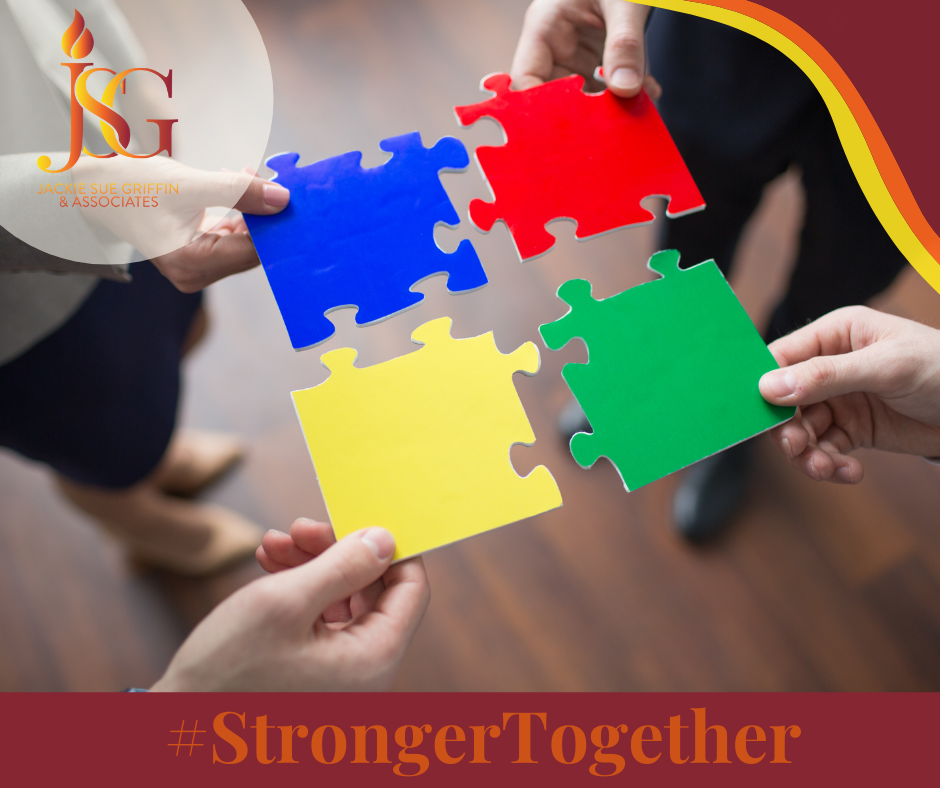10 Aug Is Your Nonprofit Ready for a Partnership or Collaboration?

By Jackie Sue Griffin, MBA, MS
Partnerships and collaborations between nonprofits are strategic alliances that achieve more significant impact than any of the nonprofits could generate on its own. These partnerships exist in many shapes and forms, from less integrated associations to unified programming, shared services and even legal mergers.
How the Partnerships are Used
Strategic nonprofit collaborations can be used for several purposes, such as increasing influence, strengthening and expanding programs and services, scaling up services or streamlining operations to gain efficiencies.
Nonprofits can use strategic partnerships to:
- Obtain greater leverage among stakeholders
- Address issues that require coordinating multiple stakeholders
- Provide continuing services to meet beneficiaries’ needs
- Strengthen or expand their programs or services
- Secure back-office or administrative efficiencies
- Reach new places, provide new services or gain new beneficiaries, etc.
These partnerships can take numerous forms. They can be:
- Coalitions, associations and collective impact collaborations
- Joint programming
- Shared services and back-office support
- Organizational mergers
How to Build Partnerships and Collaborations Between Nonprofits?
Engaging a nonprofit consultant experienced in identifying potential partners and negotiating collaborations or mergers can be very helpful. But if you’re not yet sure whether your nonprofit would benefit from exploring collaborative relationships with one or more agencies, here’s a five-step version of the process that can help you understand what to expect.
Step 1. Identify potential organizations to work with and start conversations.
Perform market mapping and landscape analysis to determine which peers might make potential partners.
Step 2. Determine strategic needs and set expectations.
The motivation for collaboration should be benefits that can only be realized through partnership. Invite key stakeholders to a meeting to determine whether the partnership would enhance the nonprofits’ strategic plan, intended impact and theory of change while also determining the level of collaboration required to achieve the desired effects.
Step 3. Think of practical implementation challenges.
Considering organizational structure and culture, strengths and weaknesses, leadership and governance, existing systems and back-office support, carefully consider the practical challenges of partnership. Include key staff at the nonprofits to discuss the realities of the partnership.
Step 4. Conduct due diligence and negotiate.
It’s crucial to go through due diligence and negotiation to ensure there are no unpleasant surprises once an agreement is reached and a partnership is formed. Make sure that all sides involved in the collaboration agree with and feel comfortable with all arrangements.
Step 5. Implement partnership and adjust anything if needed.
Once an agreement has been reached, nonprofits can implement their partnership through legal accord or a memo of understanding. Openly communicating, learning and adapting and tracking key performance indicators are crucial to ensuring a healthy and successful partnership.
Useful Tips for a Successful Partnership
- Beware of the “scarcity mindset.” A scarcity mindset can limit all the potential upsides of the partnership. Instead, celebrate the skills, resources and contacts that you share with your partners—and how your partnership will increase those positives and your impact.
- Be honest. Nonprofits need to trust each other to share both power and responsibilities. Earning trust takes some time, but you can intentionally create opportunities to address trust issues and call out friction points with your partners.
- Accept mistakes and take risks. One of the frustrations of partnerships can be the apparent need to repeat something that hasn’t worked previously for one of the partners. Instead of frustration, make sure to review lessons learned together. Also, don’t be scared to take risks because of previous mistakes. When a partnership is open and honest and provides a supportive environment of mutual learning and striving, that might be the best time to take a risk.
Here at JSG & Associates, we support the passionate leaders who make nonprofits successful. For more information about us, visit our website.
Stay up-to-date: Follow us on Facebook, Twitter, LinkedIn and subscribe to our monthly newsletter now.

No Comments